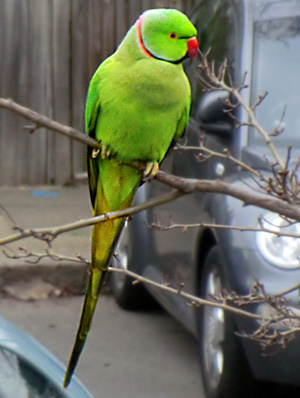 There was a time I was scathingly scornful of suburbia. Growing up in Lewisham, I couldn’t really see the point of it. Since then, I’ve moved steadily through the zones, both north and south of the river, heading for the periphery. These days, I’m thoroughly and happily ensconced deep in zone 6. And here, in Kingston upon Thames, with apologies to the Pet Shop Boys, you’re more likely to walk with the foxes than run with the dogs at night.
There was a time I was scathingly scornful of suburbia. Growing up in Lewisham, I couldn’t really see the point of it. Since then, I’ve moved steadily through the zones, both north and south of the river, heading for the periphery. These days, I’m thoroughly and happily ensconced deep in zone 6. And here, in Kingston upon Thames, with apologies to the Pet Shop Boys, you’re more likely to walk with the foxes than run with the dogs at night.
During the day, I spend a lot of time gazing at the bird feeder by the hawthorn tree in my front garden. With numerous lavender plants lining the path, a huge pink hydrangea near the door, and a large rambling honeysuckle threatening to take over, I suppose it’s typically suburban, but it’s no worse for that. The ring-necked parakeets are colourful, noisy and boisterous, tucking into the sunflower hearts. The goldfinches are like silent yellow darts, flashing across your eyeline, heading for the niger seed. But it’s the sparrows I love best.
We have a colony that nests in the nearby hedges, and these twenty or so gregarious birds spend all day eating the seed and fat balls that I thoughtfully provide. On top of all this, they manage to look cheerful while they do it.
I’m not sure “colony” is the right collective noun for them, though. “Host” puts me in mind of daffodils. “Ubiquity” seems too poetic for my prosaic soul. I’ve come across “quarrel” before and, on consideration, this does look and sound appropriate. But times are not good for this ultimate avian opportunist. In London, we lost 68% of them between 1994 and 2000, and my suburban garden is lucky to have so many. Studies show their London population as a doughnut: hardly any at all in the centre, but clustered on the outskirts – a lot like Boris Johnson voters. The reasons are complex, and many august organisations are undertaking research into ways to halt and reverse the decline.
Of sparrows, not Boris Johnson voters.
But as I stand, sipping my tea, I realise I haven’t noticed the starlings. Which is odd, really, because their feeding is accompanied by constant chirpy, squawky singing. The ones in my garden have a slightly bedraggled look, despite their dotty iridescent feathers. And I’m in no doubt as to what their collective descriptor is – “murmuration”. (All that time taking part in pub quizzes hasn’t been a total waste.) Mesmerising clouds of starlings used to darken London’s skies, but those days, sadly, are long gone. Now, the gangs of these streetwise birds are, like the sparrows, quietly dwindling at a worrying rate; down almost two-thirds since 1993. (If you’d like to re-live those good old days, you can pop down to Brighton and watch the starlings swoop and dive and soar with their mates by the pier at dusk. It really is worth a look.)
Even my best friends would say I’m no gardener but, by a process of trial and error, and a bit of luck, I’ve adapted the garden to suit all these birds – I think of it as an urban meadow. (Does that sound presumptuous, or should I be copyrighting it?) The results so far have made me think I ought to investigate this a bit more, too. After all, stuff you learn in pub quizzes can only take you so far. Watching all these birds is a simple pleasure, and anything I could do to increase their numbers would be good for them, good for me and – you know what? – good for London.

